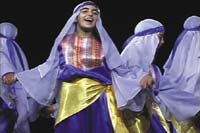Middle East

The Ibdaa Dance Troupe
Dancing for Peace
 |
| A performance by the Ibdaa Dance Troupe (Photo courtesy of the Middle East Children's Alliance). |
Manar Faraj’s wail reverberates through the packed auditorium in New York, her shrill lament piercing the darkness. “Tell me the tale of our country,” she calls out in Arabic, her slight body trembling with the force of her voice. Standing in the shadow behind her, another young woman, Tamara Abulaban, sings along in a soft, sad echo.
“Tell me the story of men who go out and come back in coffins,” they chant in the refrain of a song that goes on to paint a picture of violence, oppression, and death. When they are finished, the audience bursts into applause.
Manar and Tamara are no strangers to the stage or to the bleak themes they portray, even though they are just 16 and 17 years old.
As members of the Ibdaa Dance Troupe, based in the Dheisheh refugee camp just outside Bethlehem, they have performed in dozens of European and U.S. cities, dancing and singing about their lives in a war zone.
Combining the traditional debke—a group dance to upbeat, quintessentially Middle Eastern rhythms—with modern choreography and theater, these teenagers have created a form of storytelling all their own. Wearing colorful Palestinian costumes, they create short dances about life under occupation.
One of their dances, “The Tent,” tells of the fate of Palestinian farmers when they were separated from their land in 1949. The title refers to the sea of tents that Dheisheh refugees called home for almost a decade after they left their villages, before the United Nations built more permanent brick homes for them.
Another, more provocative piece, “Political Prisoners,” relies on pantomime to convey the youngsters’ perceptions of living under an Israeli regime that they say penalizes innocent Palestinians caught up in the Israeli-Palestinian conflict.
One piece in the show does not involve dance. Performed by Manar and Tamara, it is a popular lament sung by Palestinian prisoners in Israeli jails.
“I am here to dance, to let the people know our history, our lives, how we are living in Palestine,” Tamara says in an interview. A lively girl with spirited brown eyes, she makes her case to anyone who will listen.
The Dheisheh refugee camp houses more than 11,000 Palestinians in an area of about half a square kilometer. Often, two or three generations share the one- or two-room brick units built by the United Nations half a century ago. Infrastructure within the camp is poor: The families that live there do not have money to spend on improving it, and anyway see the camp as a temporary home. Once there is peace, they maintain, they will return to their villages.
“It’s so crowded,” says Tamara, “It’s like a jail. We can’t go outside because all the time there are curfews.…In the summer there is no water, and in the winter there is no electricity.”
Tamara is not alone in her complaints. After each performance, the dancers come onstage for an extended question-and-answer session, trying to help viewers understand what life is like for teenagers in the Occupied Territories. But, at least in some way, their own lives are better than those of most of their peers: they have Ibdaa, the only organization of its kind in the area.
Founded in 1994 as a grassroots organization, the Ibdaa Cultural Center is now a thriving educational institution. It seeks to benefit the most vulnerable members of the Dheisheh community: children and women. As well as housing the dance troupe, the center is home to a women's handicraft cooperative, a children's library, and a unique guesthouse that offers international visitors an opportunity to stay at Dheisheh. Ibdaa's dance company has been performing internationally for almost 10 years; its original members are now training the second and third generations of dancers, and profits from its international performances are used to fund the center's other programs.
In Arabic, ibdaa means “to create something out of nothing,” a principle that has served the organization well when the center has been destroyed by fires or Israeli raids, as has happened several times over the past three years during escalating tensions in the region.
Though the company has not yet been able to perform in Israel because the dancers cannot get entry visas, it continues to rehearse and perform to audiences across the world.
The company’s first U.S. tour in 1999 was an eye-opener for many of the dancers, who did not expect the overwhelmingly positive audience response they received.
“I was surprised because I was thinking that nobody here knows about us, or supports us, and maybe the American people don’t love us,” says 16-year-old Sanabel al-Fararja, reflecting the widespread Palestinian belief that U.S. support for Israel harms their cause. “But when I came here, all my ideas changed. I now know there are people who think about us.”
Sanabel’s face might be familiar to U.S. audiences: In 2001 she was featured in an Oscar-nominated PBS documentary called Promises about kids on both sides of the Israeli-Palestinian conflict. Invited to the Academy Awards last year, she rubbed shoulders with Nicole Kidman and chatted with Kate Winslet, all the while carrying with her an appeal for peace that she had prepared to read if Promises won. Although the film didn’t win, Sanabel says she enjoyed basking in the spotlight.
The ease with which Sanabel and the others navigate the contrasting worlds they inhabit might seem astonishing, considering the realities they face at home.
“You can see the tanks and soldiers and weapons everywhere,” says 17-year-old Mutassim Issa, who says his brother was killed by Israeli soldiers at the age of 12. Mutassim adds that his neighbors’ houses have been bombed, and tells of being rounded up with 1,200 other males from the camp and jailed for two days without charge.
Tamara has a similar story. Her father was arrested when he was 16, she says, and not released until he was 32. She says he was not guilty of any crimes and his imprisonment has strengthened his resolve to resist the occupation through peaceful means. Tamara says she has learned from his experience.
“I really need to make peace,” she says. “I need to hear the sounds of the birds and I don’t want to hear the sounds of the shooting. I want to smell flowers and not smell tear gas.”
Dancing is her way of bringing change, Tamara says; it enables her to feel that she’s doing something positive, making audiences around the globe aware of the conditions under which ordinary Palestinians live. “I need to live like all the children and all the other people,” she says. “While you are living a wonderful life here in the United States, we are living a terrible life in Palestine.”







